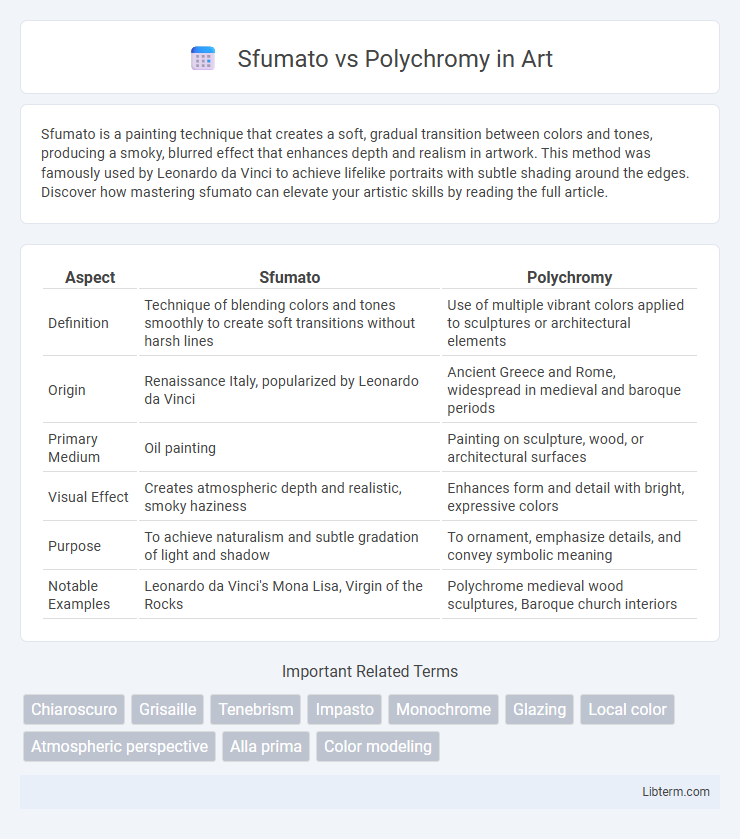Sfumato is a painting technique that creates a soft, gradual transition between colors and tones, producing a smoky, blurred effect that enhances depth and realism in artwork. This method was famously used by Leonardo da Vinci to achieve lifelike portraits with subtle shading around the edges. Discover how mastering sfumato can elevate your artistic skills by reading the full article.
Table of Comparison
| Aspect | Sfumato | Polychromy |
|---|---|---|
| Definition | Technique of blending colors and tones smoothly to create soft transitions without harsh lines | Use of multiple vibrant colors applied to sculptures or architectural elements |
| Origin | Renaissance Italy, popularized by Leonardo da Vinci | Ancient Greece and Rome, widespread in medieval and baroque periods |
| Primary Medium | Oil painting | Painting on sculpture, wood, or architectural surfaces |
| Visual Effect | Creates atmospheric depth and realistic, smoky haziness | Enhances form and detail with bright, expressive colors |
| Purpose | To achieve naturalism and subtle gradation of light and shadow | To ornament, emphasize details, and convey symbolic meaning |
| Notable Examples | Leonardo da Vinci's Mona Lisa, Virgin of the Rocks | Polychrome medieval wood sculptures, Baroque church interiors |
Introduction to Sfumato and Polychromy
Sfumato is a painting technique characterized by delicate gradations of tone and color to create soft transitions without harsh outlines, famously used by Leonardo da Vinci in works like the Mona Lisa. Polychromy involves the application of multiple colors in sculpture and architecture to enhance realism and decorative richness, with roots tracing back to ancient Greek and Roman art. Both techniques serve distinct artistic purposes: sfumato enhances atmospheric depth and subtlety in paintings, while polychromy emphasizes vividness and visual impact in three-dimensional forms.
Historical Origins and Evolution
Sfumato originated during the Renaissance, developed by Leonardo da Vinci to create soft transitions between colors for realistic depth and volume in painting, emphasizing subtle gradations without harsh lines. Polychromy traces back to ancient civilizations like Egypt and Greece, where multiple vivid colors were applied to sculptures and architectural elements to enhance visual impact and convey symbolic meaning. Over time, sfumato evolved as a sophisticated technique in oil painting, while polychromy persisted primarily in decorative arts and sculpture, reflecting differing artistic intentions and historical applications.
Key Techniques and Methods
Sfumato employs delicate blending of colors and tones to create soft transitions and a smoky effect, emphasizing subtle gradations without harsh lines. Polychromy utilizes vibrant, multi-hued pigments applied in distinct layers or sections to highlight texture and enhance visual contrast. These contrasting methods illustrate how sfumato's smooth tonal shifts differ fundamentally from polychromy's bold, colorful surface treatments in art and sculpture.
Notable Artists and Their Works
Leonardo da Vinci is a notable artist renowned for mastering sfumato, with "Mona Lisa" exemplifying its subtle gradations and soft transitions. In contrast, Polychromy features prominently in works by El Greco, whose paintings like "The Burial of the Count of Orgaz" showcase vibrant, multi-colored layers enhancing emotional intensity. Titian also excels in polychromy with his richly colored Renaissance portraits, blending vivid pigments to create depth and realism.
Visual Characteristics and Effects
Sfumato creates a soft, gradual transition between colors and tones, producing a smoky, blurred effect that enhances depth and realism in paintings. Polychromy employs vibrant, distinct colors applied in layers or sections, resulting in a vivid, decorative appearance with strong contrasts. While sfumato emphasizes subtle tonal gradations for atmospheric perspective, polychromy highlights bold color differentiation to enhance visual impact and ornamental detail.
Cultural and Regional Influences
Sfumato, originating from the Italian Renaissance, reflects the region's emphasis on naturalism and subtle tonal transitions, deeply influenced by Florence and Leonardo da Vinci's mastery. Polychromy, prevalent in ancient Greek and Roman art as well as Gothic sculpture, highlights cultural preferences for vivid color and symbolic meanings tied to religious and societal contexts. These distinct techniques embody the divergent aesthetic values shaped by their respective cultural and regional environments across Europe.
Sfumato in Renaissance Art
Sfumato, a technique perfected by Leonardo da Vinci during the Renaissance, involves the delicate blending of colors and tones to create soft transitions without harsh lines, enhancing realism and depth in portraiture. This method contrasts with polychromy, which emphasizes vivid, multi-colored surfaces often used in sculpture and architectural elements to convey symbolism and narrative. The subtlety of sfumato revolutionized early Renaissance art by enabling artists to depict atmospheric perspective and human emotion with unprecedented naturalism.
Polychromy in Classical and Modern Sculpture
Polychromy in classical sculpture involved the application of vibrant pigments to enhance realism and highlight details, transforming marble statues into lifelike representations with rich colors. In modern sculpture, artists revived polychromy by integrating diverse materials and bold color palettes to challenge traditional monochromatic norms, creating visually dynamic and expressive works. The contrast between sfumato's subtle tonal blending and polychromy's vivid coloration underscores different artistic approaches to texture, depth, and visual impact across historical periods.
Contemporary Applications and Interpretations
Sfumato, characterized by its subtle gradation of tones to create a smoky, soft-focus effect, is widely applied in contemporary digital art and portrait photography to evoke depth and emotional nuance. Polychromy, involving the use of multiple vibrant colors on sculptures or architectural elements, finds renewed interest in modern urban art and restoration projects, enhancing visual impact and cultural narrative. Both techniques influence contemporary design by offering distinct approaches to texture and color, shaping aesthetic experiences in visual storytelling and interactive media.
Comparing Impact on Art Perception
Sfumato creates a soft, gradual transition between colors and tones, enhancing the perception of depth and realism in portraits by mimicking natural light and shadow. Polychromy employs vibrant, multi-colored surface decoration that emphasizes contrast and symbolic meaning, often making artworks more visually striking and emotionally engaging. The interplay of sfumato's subtle blending versus polychromy's bold coloration fundamentally shapes how viewers interpret texture, dimension, and narrative in art.
Sfumato Infographic

 libterm.com
libterm.com